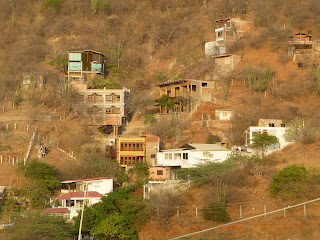Santa Marta is a well known colombian city at the Caribbean coast. It is third in size in the region after Cartagena and Barranquilla. Quoting Lonely Planet: "Santa Marta is the place where colombians go when they want sun on their backs, sand under their feet and rum in their glasses". Sounds like a good place to be! After 4 months, around 20.000 km and 7 countries I'm now there, at the Caribbean sea.
For many travelers Santa Marta is also the base for reaching Taganga beach, the Tayrona National Park and Ciudad Perdida (The Lost City).
But before we get into Santa Marta, there was one thing I needed to solve since Manaus: my camera, a Panasonic DMC-TZ31 stopped working. It happened during the river tour, It accidentally felt from my hands (powered off and in its case) on a wooden floor. I had this camera for about 2 years and was not the first time it felt, but for some reason it felt harder this time. It probably landed just flat on its back. The thing is that since that moment it would display a "Zoom-error" message when turned on. I searched internet for hints and tried shaking it as recommended, without success. I didn't try opening it as most posts mention the need of a "vacuum lab room" and warn about dust possibly ruining the lens. I really thought I would have to buy a new camera or keep using my mobile for photos. My stay in Leticia was too short but once in Santa Marta I decided to spent one morning and find a shop to buy a new camera. Fortunately, while looking for a camera shop I accidentally found a place near the market and close to my hostel that claimed to repair cameras. It was a small kiosk run by two young men. It looked anything but "high-tech", in fact this is a photo of their backstage behind their desk:

The guys were very friendly and after I explained the problem they were very confident they could solve it. I waited a couple of minutes for them to complete the chicken soup their were having as breakfast on their working desks before one of them checked the camera. I thought this is for sure not a "dust free vacuum room", but there is no much I can loose; I will have to buy a new one anyway. But the guys working there were very knowledgeable and in less than ten minutes one of them, the boss I guess, had carefully removed lots of tiny screws, holders and plugs and had the camera completely open, with all circuits, screen, panel and the zoom unit laying on the desk, not far from his empty breakfast dishes. At the beginning he couldn't find any mechanical damage and assumed the shock had just jammed the zoom mechanism and opening the camera just fixed it. He partially reassembled it and tried to start it but there was still the Zoom-error message.
He then reopened the camera and looked at the electrical parts with a magnifying glass (actually the zoom lens from an older camera), and found that the flat power cable of the zoom unit had a crack. He showed it to me and I could see it bended but was too small to see any crack. He then bypassed this cable by solding two extra tiny wires, reassemble everything (as far as I could see) and turned the camera on. It worked!!
I tried different shots, zoom, manual and auto settings and functions for a few minutes and found everything to be working, just as it was before the problem started. The total time spent was less than 1 hour; total cost for me: 11 EUR. Great!
Then, with a working camera on my hands, I walked around Santa Marta. Here some photos from downtown:




Santa Marta was founded by the spanish Rodrigo de Bastidas in 1525 and belongs to the oldest hispanic cities in the continent. The location was chosen due to its attributes as harbor and its proximity to the settlements of the Tayrona natives.
Today, Santa Marta has around 0,5 million inhabitants and is the capital city of the Magalena department in Colombia. A wall on a local restaurant shows the predilect sons of this department including Nobel prize holder Gabriel Garcia Marques and Colombia's soccer legend Carlos "Pibe" Valderrama.
In this restaurant I tried the colombian Cebiche which was a bit to small and acid for me:
and pasta with fresh seafood. This was really good.
Santa Marta's beach close to the center is polluted and not the place to go. For this reason most foreign visitors prefer Rodadero or Tayrona beaches.
Historically speaking, Santa Marta was not a central place of activities in the past. One event that is however well kept is the place where Simon Bolivar died. He was one of south america liberators against the spanish crown.
The house also hosts a number of iguanas. They are very common in the region but hard to find inside the city.
Tayrona beach is just a 15 min drive east from Santa Marta. This old fishing town boomed in the last years and has become a major hippie place. Some like to celebrate their wedding here.







































No comments:
Post a Comment